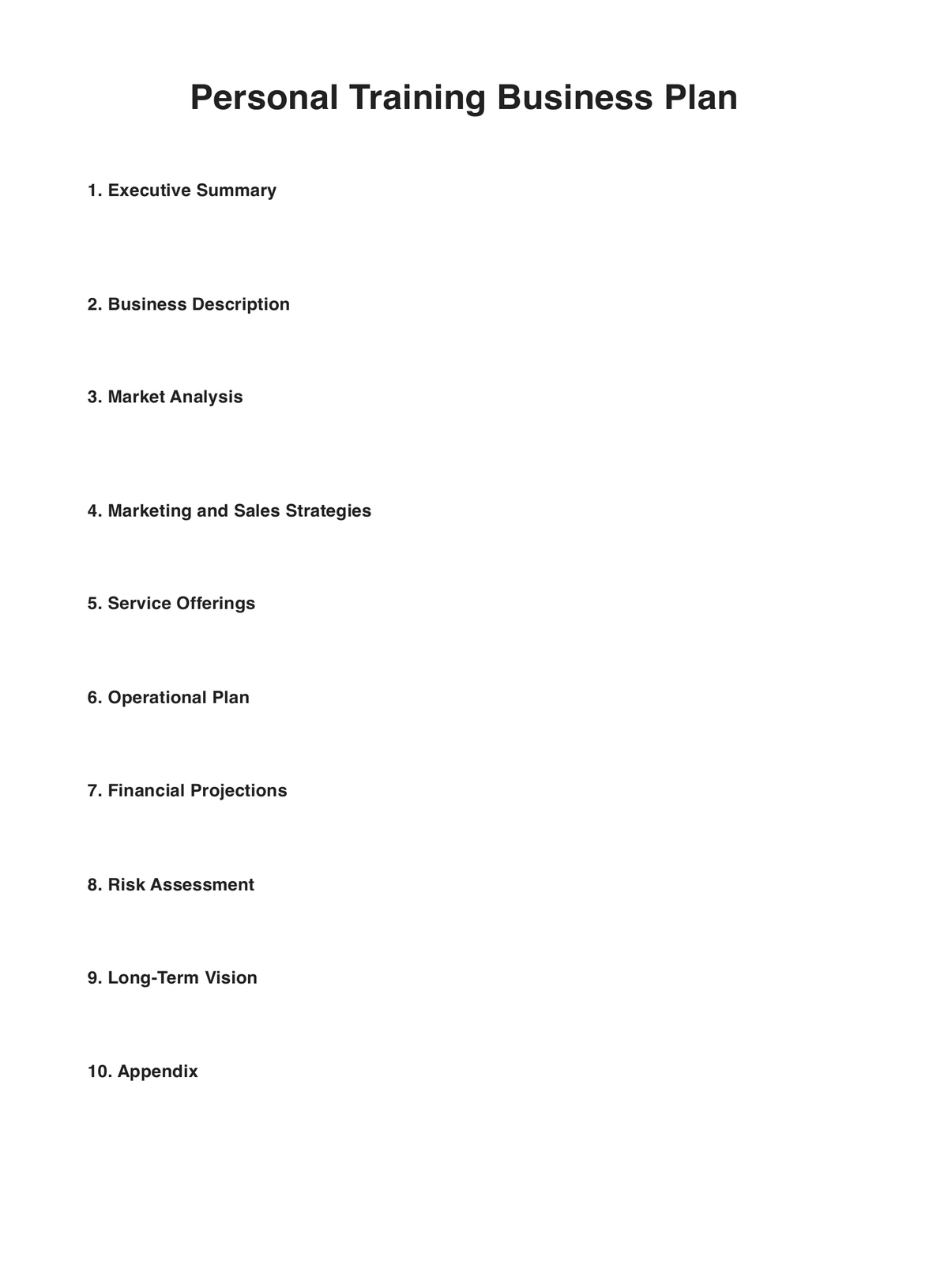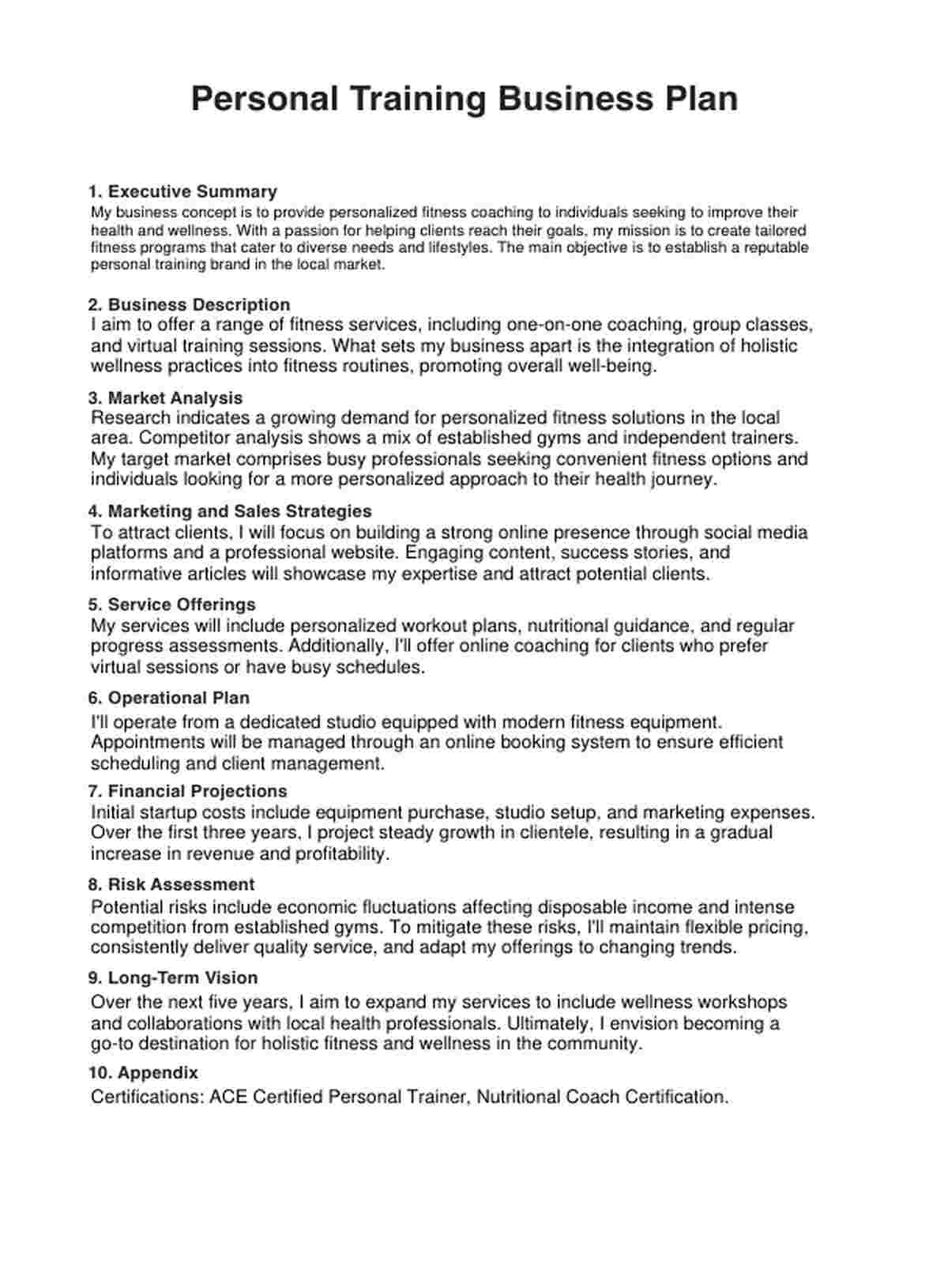
Create a successful fitness venture with a Personal Training Business Plan. Strategize growth, attract clients, and achieve your goals in the industry.

By Joshua Napilay on Jul 15, 2024.
 Plans PDF Example" />
Plans PDF Example" />

A Personal Training Business Plan is a comprehensive document outlining the strategies, goals, and operational details of establishing and running a successful personal training business. This plan serves as a roadmap for individuals looking to enter the fitness industry as entrepreneurs. It outlines their approach to attracting clients, delivering effective training programs, managing finances, and achieving long-term growth.
A well-structured business plan typically includes several key components:
Creating a is essential for various reasons. It helps entrepreneurs clarify their business concept, secure funding from investors or lenders, and maintain focus on their objectives. Additionally, it offers a structured approach to navigating challenges and adapting to changes in the fitness industry.
PDF Template Example PDF Plans PDF Example" />
Plans PDF Example" />
 Plans PDF Example" />
Plans PDF Example" />
Access the Printable Personal Training Business Plan form from a reliable source, ensuring it's in a downloadable and printable format.
Enter your details, including your name, contact information, and professional certifications.
Provide a brief overview of your training business, including its mission, goals, and fitness services you intend to offer.
Specify your target clientele, such as age groups, fitness levels, and specific fitness goals your training programs cater to.
Describe the local fitness landscape and identify key competitors. Highlight what differentiates your business from others regarding services, pricing, and approach.
Share your marketing plan, both online and offline, to attract clients. This may include social media, partnerships, or community events.
Detail the different training programs you will provide, mentioning if it's one-on-one coaching, group classes, virtual training, or a combination.
Explain how you plan to run the day-to-day operations of your business, covering aspects like scheduling, location, equipment, and any additional staff.
Present your expected revenue and expenses for the first few years of operation. This includes startup costs, recurring expenses, and anticipated income.
Identify potential business risks, such as economic downturns or legal considerations. Discuss how you plan to mitigate these risks.
Share your vision for the future of your personal training business, including expansion plans, new service offerings, and ways you intend to adapt to industry trends.
Carefully review the completed form for accuracy, coherence, and completeness. Make any necessary revisions before finalizing the document.
Consider seeking input from a business advisor, fitness industry expert, or mentor to ensure your plan is thorough and well-structured.
Once your Personal Training Business Plan is complete, use it as a guide to implement your strategies and work towards achieving your business goals.
A Personal Training Business Plan is an invaluable tool for fitness enthusiasts and professionals looking to venture into the personal training industry as entrepreneurs. This resource helps them strategically plan and execute their fitness business ventures. Here are some instances when this form would be particularly useful:
The form guides personal trainers in articulating their business goals, target market, and unique value proposition, leading to a more focused and effective strategy.
A well-structured plan showcases the potential of the personal training business, instilling confidence in investors and increasing the likelihood of securing funding.
The form aids in planning day-to-day operations, from scheduling sessions to managing resources, leading to streamlined and organized business management.
By defining the ideal client and specifying marketing strategies, trainers can attract their desired clientele more effectively, optimizing marketing efforts.
The form's financial projections help trainers understand startup costs, operating expenses, and projected revenue, enabling better financial planning and management.
With a well-documented plan, trainers can proactively adapt to changing industry trends, keeping their services relevant and fostering sustainable growth.
The use of personal training business plans has evolved alongside the growth of the fitness industry and the increasing number of individuals pursuing careers as personal trainers. As the demand for fitness services expanded, it became evident that having a structured business plan was crucial for success in a competitive market. Over the years, this resource has gained significance due to the following factors:
In the past, personal training was often limited to elite athletes or wealthy individuals. However, as awareness of fitness and health benefits spread, more people sought professional guidance. This shift led to a proliferation of personal training businesses, necessitating the development of effective business strategies.
Studies and industry reports have highlighted the advantages of having a well-defined business plan in the personal training sector. Research by industry associations, such as the International Health, Racquet & Sportsclub Association (IHRSA), consistently emphasizes the value of strategic planning for fitness businesses.
With the fitness industry becoming more saturated, personal trainers realized that merely having expertise in exercise science wasn't enough. Business acumen and effective marketing strategies were essential to stand out. Research-backed business plans emerged as tools to help trainers navigate the complexities of entrepreneurship.
As the fitness industry expanded, entrepreneurs sought external funding to establish or grow their personal training businesses. Financial institutions and investors require evidence of a sound business strategy before providing funding. This prompted personal trainers to develop detailed business plans to secure backing.
The fitness industry is dynamic, with trends like virtual training, wellness coaching, and specialized programs constantly emerging. Research-backed business plans allow personal trainers to incorporate these trends strategically, ensuring their businesses remain relevant and profitable.